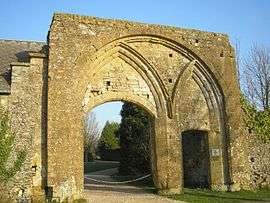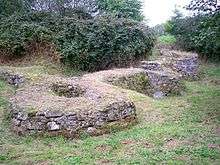Priory of Plessis-Grimoult
The priory of Plessis-Grimoult is a twelfth-century French priory built by the "Order of the Regular Canons of St. Augustine" located in Le Plessis-Grimoult in the department of Calvados. It was listed as a national heritage site in 1928, and the nearby archaeological site and the remains of the fortified garden were listed in 1996.[1]
| Priory of Plessis-Grimoult | |
|---|---|
Prieuré du Plessis-Grimoult | |
 Guillaume Causson's 13th-century doorway | |
| Religion | |
| Affiliation | Catholic Church |
| Region | Normandy |
| Deity | Christian God |
| Patron | Saint Stephen |
| Year consecrated | 1131 |
| Location | |
| Municipality | Plessis-Grimoult |
| Country | France |
| Geographic coordinates | 48°57′43″N 0°36′30″W |
| Architecture | |
| Founder | Richard Samson |
History
Establishment
In 1047 the local baron, Grimoult of Plessis was executed for an attempted coup against the Duke of Normandy and his lands were given to the duke's half brother, the Bishop of Bayeaux, to become part of his diocese.[2] In 1131 the local church was dedicated to Saint Stephen.
Around 1135, William the Conquerer's former chaplain, Richard Samson, was the local priest. He brought a community of Canons regular to Plessis-Grimoult and in so doing became the first Prior there. The canons lived in Samson's own presbytery at that time. In 1153 under Samson's successor, the cannons moved to Champ Osburt. Under Prior Henri I the canons moved to the Chateau de Vire. The church building and priory in its current location were built in the late 13 century under the direction of Prior Guillaume Causson, Henri I's successor. Only the priory's entryway remains standing today.[3]
Under Bossuet
Jacques-Bénigne Bossuet became the tutor to the Grand Dauphin in 1671. The time his new position required him to spend at court meant he could no longer serve as Bishop of Condom. Because of this he lost access to all the monetary benefits he was entitled to as Bishop and could not afford to live the lavish lifestyle that came with living at court. To compensate his son's tutor, Louis XIV appointed him to be the prior of Plessis-Grimoult. This provided Bossuet with a steady income, without requiring too much of his time.
During his time as prior he had a dispute with Julian de Saint-Germain, the priest of Maisoncelles-la-Jourdain, over the collection of tithes. There was a trial on the 18th of August, 1677 which found that Saint-Germain had to pay Bossuet an annual sum of 230 livres in exchange for Bossuet giving up his right to collect tithes in Maisoncelles.[4]
Priors
The Priory had 35 Priors from its founding to the nationalization of church property during the French Revolution.
| No. | Name | Years in office | Notes[3] |
|---|---|---|---|
| 1 | Richard Samson | ~1135-1153 | Founder. |
| 2 | Nicholas Coquin (Nicholas I) | 1153-1190 | Moved priory to Champ Osburt |
| 3 | Étienne I | 1193-Unknown | |
| 4 | Radulphe | Unknown-1210 | Distant relative of Baron Grimoult |
| 5 | Guillame I | 1210-1234 | |
| 6 | Pierre de la Barre (Pierre I) | 1234-1250 | |
| 7 | Henri | 1250-Unknown | Moved Priory to the Chateau de Vire |
| 8 | Guillaume Causson (Guillaume II) | Unknown-1290 | Built the Church and the Priory's entryway (which still stands today) |
| 9 | Richard le Moine (the monk) | 1290-1314 | |
| 10 | Guillaume Pinçon (Guillaume III) | 1314-1340 | |
| 11 | Guillaume de Canteil (Guillaume IV) | 1340-1369 | Reduced the number of canons from fifty-six to forty-five |
| 12 | Jean Maufras (Jean I) | 1370-1398 | |
| 13 | Pierre de Missy (Pierre II) | 1398-1400 | |
| 14 | Matthieu de Chaumoncel | 1400-1412 | |
| 15 | Guillaume de l'Orme (Guillaume V) | 1412-1433 | |
| 16 | Jean Marivint (Jean II) | 1433-1457 | Buried in the Church |
| 17 | Pierre de Missy (Pierre III) | 1470-1477 | |
| 18 | Bertin Marvint | 1477-1480 | Nephew of Jean Marvint |
| 19 | Gabriel le Veneur | 1480-1523 | |
| 20 | Nicholas de Saint-Germain (Nicholas II) | 1523-1543 | Uncle of the next Prior |
| 21 | Guillaume de Saint-Germain (Guillaume VI) | 1543-1582 | During his Priorship Calvinists burned down most of the Priory |
| 22 | Robert Maunoury | 1582 | |
| 23 | Francois de Lusignan | 1582-1592 | |
| 24 | Louis Cochu | 1592-1604 | |
| 25 | Jean le Bel, or le Bel de Nantes | 1605-Unknown | |
| 26 | François de Montmorency (Francois II) | 1612-1618 | Beheaded in 1627 because he broke the law against dueling |
| 27 | Louis de Montmorency (Louis II) | 1618 | Brother of the previous |
| 28 | Étienne le Berger (Étienne II) | 1618-1625 | |
| 29 | Georges du Fay | 1625-1651 | |
| 30 | Jaques de Matignon | 1652-1670 | |
| 31 | Jacques-Bénigne Bossuet | 1671-1704 | Tutor to the eldest son of Louis XIV |
| 32 | Marie-Joseph d'Hostung | 1704-1706 | |
| 33 | Léonor Goyon de Matignon | 1706-1757 | Cousin of Jacques I, Prince of Monaco |
| 34 | M. Lemercier | 1757-1787 | |
| 35 | Louis-François de Berton du Prat | 1787-1789 | Last Prior of Plessis-Grimoult |
Architecture

In 1830 the building consisted of a transept terminating in an apse. There were several columns with capitals which dated back to the 13th century. The choir was older than the tower. The roof was non-existent by 1830, having most likely been made of wood. The western wall of the cloister was still standing. Two doors open on the gallery of the cloister, the capitals of the columns are from the end of the 14th or 15th century. In the other rooms on the ground floor, the eight-sided columns have capitals that are perhaps from the 14th century. There is a beautiful fireplace in a room that is believed to be the kitchen. Gardens and ponds are farther to the east. To the west of the outer courtyard of the priory, there is a doorway that dates to about the thirteenth or fourteenth century.[5]
Parishes Served
The priory served the parishes of Plessis, Roullours, Carville, Chênedollé, Truttemer-le-Grand, Montsecret, Sainte-Honorine-la-Chardonne, Saint-Jean-le-Blanc, Campandré, Monchauvet, Frênes, Saint-Vigor-des-Mézerets, Périgny, Cauville, Proussy, Bernières-le-Patry, Maisoncelles-la-Jourdan, Estry, Saint-Christophe-de-Chaulieu, Beauchêne, Clairefougère, Saint-Cornier-des-Landes, Saint-Jean-des-Bois, Saint-Quentin-les-Chardonnets, Yvrandes, Bonnemaison, Courvaudon, Feuguerolles-Bully, Fontaine-Étoupefour, Rosel, La Cambe, Osmanville, Mondrainville, Noyers-Bocage, Planquery, Saint-Germain-d'Elle, Bretteville-le-Rabet, Campeaux, and Colombelles.
References
- Ancienne abbaye » [archive], notice no PA00111601, base Mérimée, ministère français de la Culture .
- Élisabeth Zadora-Rio : Enceinte fortifiée du Plessis-Grimoult.
- Alix, Frederic (1911). Les abbés du prieuré Saint-Etienne du Plessis-Grimoult, ordre de Saint-Augustin au diocèse de Bayeux [The Abbots of St. Stephen's Priory in Le Plessis-Grimoult, Ordre of St. Augustin in the diocese of Bayeux] (in French). Revue d'histoire de l'Église de France. pp. 728–733.
- Gaston, Jean (1912), "Une transaction entre Bossuet et le curé de Maisoncelles-La-Jourdan", Revue d'Histoire de L'église de France (in French), 14: 174–177
- Arcisse de Caumont, Statistique monumentale du Calvados, vol.3 : Arrondissements de Vire et de Bayeux, Caen, Hardel, 1857 (lire en ligne [archive])], p. 223.